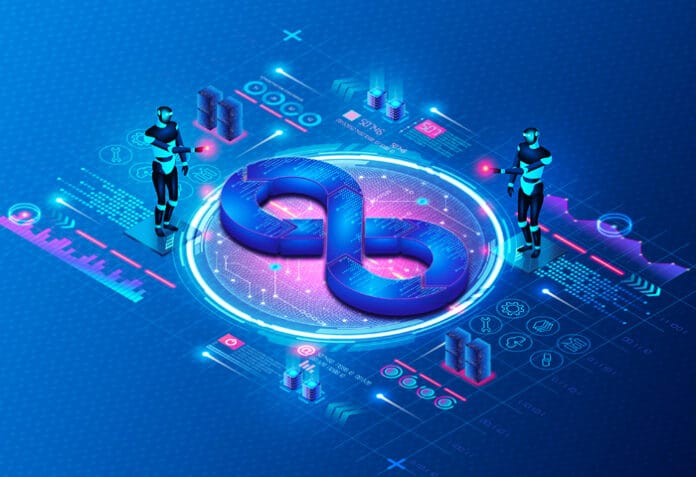Enterprises must embrace DevOps and its evolutionary trends to ensure they stay ahead of the competition and remain customer-centric. Here are some insights into the pivotal DevOps trends of automation, security, AI integration, and more, and how they benefit organisations.
In recent years, DevOps has become a crucial component of software development and delivery, enabling teams to collaborate and deliver high-quality applications at a faster pace. As organisations increasingly adopt DevOps practices, the industry is witnessing new trends and advancements that are shaping its future. One significant trend is the shift towards automation, enabled by tools like Kubernetes and Jenkins. The adoption of artificial intelligence and machine learning is also gaining momentum, as organisations seek to optimise their DevOps processes further.
Another trend is the rise of observability, which enables teams to gain valuable insights into their application’s performance and user behaviour. This approach involves the collection and analysis of various data points, such as logs, metrics, and traces, to identify potential issues and improve overall system health.
In the coming years, DevOps is expected to continue evolving, with a greater emphasis on security and compliance. The use of DevSecOps practices, which integrate security measures into the development and delivery process, is becoming increasingly crucial as cyber threats become more sophisticated.
Importance of keeping up with DevOps trends
Stay ahead of the competition: Staying up-to-date with the latest trends in DevOps can help organisations stay ahead of the competition and stay relevant in the market.
Improve productivity: DevOps trends often focus on improving automation and efficiency in the development process, which can result in improved productivity for your team.
Enhanced collaboration: Keeping up with DevOps trends can also lead to better collaboration between different teams and departments within an organisation.
Better quality software: Following DevOps trends can also help organisations deliver better quality software, through improved testing processes and faster release cycles.
Reduce costs: DevOps trends often emphasise reducing the time and costs associated with development and deployment, which can lead to significant cost savings for your organisation.
Current DevOps trends
DevOps is an essential methodology that helps organisations to improve their software development life cycle by aligning their development and operational teams. The DevOps culture is continuously evolving, and with more companies adopting this approach to improve their software delivery, we can see some significant DevOps trends emerging in the technology world. Let’s take a look at some of the exciting and innovative trends that are driving DevOps forward.
Automation: Automating repetitive tasks such as server configuration, application deployment, testing, and monitoring is becoming increasingly popular to minimise human errors and speed up the delivery process.
Continuous delivery: Continuous delivery is aimed at ensuring that the software is always in a deployable state, and any changes made to the codebase can be released to production immediately.
Microservices: Rather than monolithic architecture, microservices use a collection of loosely coupled services to provide flexible, scalable, and independent development processes.
Cloud-native: Cloud-native emphasises deploying applications in the cloud instead of relying on traditional on-premises infrastructure.
Security-as-Code: Security is baked into the CI/CD pipeline so that automated testing detects vulnerabilities before they become threats.
DevSecOps: DevSecOps integrates security practices into the DevOps pipeline, so security becomes everyone’s responsibility, rather than of a separate team.
Infrastructure as Code (IaC): Infrastructure as Code is about defining and managing infrastructure using code to ensure reproducibility, consistency, and scalability.
GitOps: GitOps is a new approach to continuous delivery that uses Git as the single source of truth for managing infrastructure and applications.
Observability: Observability is the ability to monitor, understand, and troubleshoot complex systems in real-time.
Serverless computing: Serverless computing is an event-driven architecture that allows developers to deploy code without worrying about infrastructure management.
Automation and Infrastructure as Code (IaC)
Automation and Infrastructure as Code (IaC) are two closely related concepts that have revolutionised the way businesses build and manage their IT infrastructure. Automation refers to the use of tools and technologies to automate various IT operations, such as provisioning, configuration, testing, and deployment.
With automation, businesses can reduce the time and effort required to perform routine tasks, improve the accuracy and reliability of their IT operations, and free up IT teams to focus on more strategic initiatives. By automating various processes, businesses can also reduce costs and improve efficiency, enabling them to deliver products and services faster and more reliably.
Infrastructure as Code, on the other hand, refers to the practice of using code to manage and provision infrastructure. With IaC, businesses can use software code to automate the deployment and configuration of their infrastructure, making it more scalable, repeatable, and reliable. IaC allows businesses to define their infrastructure as code, which can be easily versioned, tested, and reviewed, enabling them to make changes quickly and efficiently.
IaC has several benefits, including reducing the risk of human error by automating repetitive tasks, making it easier to manage complex infrastructure, and improving collaboration and communication between different teams. Additionally, IaC can help businesses achieve regulatory compliance, as they can easily track and audit changes to their infrastructure.
Security integration into DevOps
DevOps focuses on collaboration and communication between different departments such as software development, testing, and operations to ensure the seamless and continuous delivery of software products.
However, security has often been an afterthought in the DevOps process, with many organisations prioritising speed and agility over security. This approach can result in security vulnerabilities in the software products released, leading to data breaches, cyber-attacks, and loss of user trust, which can significantly impact an organisation’s reputation and financial standing.
To address this challenge, security integration into DevOps is becoming a critical component of software development processes. This approach involves integrating security practices, tools, and workflows into the DevOps cycle to ensure that security is at the forefront of the software development process.
One of the key benefits of security integration into DevOps is that it helps to identify potential security risks early during the development process. This early detection enables security teams to work closely with the development team to mitigate any potential vulnerabilities before software products are released.
Another benefit is that security is accessible to all departments involved in the software development process, and not just the security team. This approach reduces the siloed nature of security and promotes a culture of shared responsibility for security across the organisation.
To implement security integration into DevOps, organisations can adopt various practices such as:
Implementing security testing and vulnerability assessments into the CI/CD pipeline to identify and mitigate security vulnerabilities early in the development process
Providing security-focused training to all stakeholders involved in the software development process
Implementing security automation and orchestration tools to streamline security workflows and improve collaboration between teams
Incorporating security requirements into the software development process as part of the requirements gathering phase.
Shift towards cloud-native architecture
With businesses relying on cloud computing more than ever before, cloud-native architecture has become a key focus for companies looking to deliver a more agile and scalable IT infrastructure.
Cloud-native architecture focuses on using cloud computing technologies to create complex, distributed systems. This approach emphasises the use of containers and microservices, which break down applications into smaller, more manageable parts, making them easier to deploy and maintain.
The shift towards cloud-native architecture is driven by several factors. First, businesses are looking to modernise their applications and IT infrastructure, and the cloud provides the ideal platform for this. By moving to the cloud, businesses can take advantage of the scalability and flexibility of cloud computing technologies, enabling them to deliver better services to customers and stakeholders.
Second, there is a growing need for speed and agility in software development. With cloud-native architecture, developers can work more quickly and efficiently, deploying changes to applications faster and with less disruption. This gives businesses a competitive edge, enabling them to respond quickly to changing market conditions and customer needs.
Third, moving to cloud-native architecture can help businesses reduce their IT costs, as they no longer need to maintain their own infrastructure and can instead rely on cloud providers to manage it for them. This allows organisations to redirect their resources to other areas of the business.
Adoption of microservices
Microservices are a type of software architecture where applications are broken down into smaller, independent services that work together to deliver a larger functionality.
One of the key benefits of microservices is the ability to scale and update individual services without affecting the entire system. This allows for easy and less costly updates and upgrades, and can reduce downtime. Additionally, microservices can increase resilience by allowing services to fail independently, rather than causing an entire application to fail.
To adopt microservices, businesses typically start by breaking down their monolithic application into smaller services. This can be a time-consuming process, but it allows for a more modular architecture that can adapt to changing requirements.
Another important component of microservices is the use of APIs to communicate between services. This allows for greater flexibility and interoperability, making it easier to integrate with other systems and applications.
To support microservices, businesses may need to adopt new tools, such as containerisation and orchestration platforms like Kubernetes or Docker. These technologies enable the deployment and management of microservices at scale, making it easier to manage a complex system of services.
AI and machine learning integration
One of the primary benefits of integrating AI and machine learning into DevOps is improved speed and efficiency. AI and machine learning algorithms can automate repetitive and time-consuming tasks, allowing developers to focus on more complex aspects of software development. Additionally, these algorithms can analyse large amounts of data, such as performance metrics and user behaviour data, and identify areas where improvements can be made. This enables organisations to make data-driven decisions and optimise their DevOps processes.
Another benefit of integrating AI and machine learning into DevOps is improved quality and reliability. By automating testing processes, AI and machine learning algorithms can quickly identify bugs and other issues before they become major problems. This ensures that software is developed and released with as few errors as possible, reducing the need for costly bug fixes and improving customer satisfaction.
Furthermore, AI and machine learning algorithms can help organisations to detect and respond to security threats quickly and accurately. They can monitor and analyse network traffic, detect anomalies, and flag suspicious behaviour, allowing organisations to take quick and effective action to mitigate risks.
As AI and machine learning continue to evolve and improve, we can expect to see even greater advancements in DevOps automation and optimisation.
Increased focus on observability, monitoring, and logging
In recent years, there has been an increased focus on observability, monitoring, and logging in the DevOps community. As organisations adopt modern practices for delivering software, it is important to have visibility into the performance and behaviour of applications and infrastructure.
Observability is the ability to measure the internal state of a system based on its outputs. This concept has gained traction in the DevOps world because it helps teams understand the function of software systems in real-time. By tracking metrics such as response time, error rates, and user satisfaction, teams can quickly identify and diagnose issues.
Monitoring is the process of collecting data about systems and applications in order to detect, diagnose, and resolve issues. This is especially important in complex environments where multiple services and components work together. By monitoring logs, metrics, and events, DevOps teams can identify potential problems and take proactive measures to prevent them.
Logging is the practice of recording system events and activity for later analysis. Logs are crucial for understanding the context in which issues occur, debugging complex problems, and improving overall system performance. With the rise of microservices and distributed systems, logging has become an essential component of observability.
The increased focus on observability, monitoring, and logging in DevOps is driven by several factors. First, the rise of cloud computing and containerisation has made it easier to deploy and scale applications, but it also introduces complexity. Second, DevOps teams are under pressure to deliver high-quality software at a faster pace, which requires a more efficient approach to monitoring and diagnosing issues. Finally, regulatory requirements and security concerns have made it essential to have visibility into how systems are performing and who is accessing them.
In a nutshell, observability, monitoring, and logging are critical elements of modern DevOps practices. By implementing these practices, organisations can improve their ability to detect and diagnose issues, improve system performance, and ensure compliance with regulatory requirements.
Implications of current trends
The current trends in DevOps have significant implications for businesses.
Automation: Automation tools are being used for various activities, including testing, deployment, and configuration management. Automation leads to better quality products, faster product development, and reduced time-to-market.
Cloud computing: The cloud offers scalability, flexibility, and cost savings to businesses. Cloud computing also enables teams to work remotely and collaborate effectively.
Microservices: Microservices architecture offers scalability, resilience, and flexibility to businesses.
Continuous integration and continuous deployment (CI/CD): CI/CD helps businesses to release new features and fixes rapidly, ensure quality through automated testing, and reduces the risk of production failures.
Security: The adoption of DevSecOps practices is necessary to ensure secure product development and deployment.
What’s next in DevOps?
Enterprises are keen to embrace the next-generation DevOps practices to enhance the agility, efficiency, and scalability of their software development, management, and deployment processes. Here are some of the significant developments that can shape the future of DevOps.
Securing DevOps: Security is increasingly becoming an essential concern in the DevOps arena. DevOps teams need to understand the vulnerabilities and ensure the security of the application’s infrastructure and code throughout the development and deployment cycle. Implementing security measures, such as automation, collaboration, and continuous testing, can improve the security of the DevOps pipeline.
Artificial intelligence and machine learning: AI and ML can automate repetitive tasks, detect and prevent defects, and enhance decision-making capabilities. The integration of AI and ML in the DevOps workflow can enable teams to identify areas for improvement and optimise the development and deployment process continually.
Cloud-native DevOps: Cloud-native DevOps leverages the cloud infrastructure’s scalability, agility, and flexibility to enable rapid software development and deployment. This approach involves building applications using cloud-native technologies, such as containers and microservices, and integrating them with the DevOps pipeline for maximum productivity.
Agile DevOps: Agile DevOps combines agile methodologies with DevOps practices, allowing teams to deliver software rapidly, frequently, and with high quality. This approach involves collaboration, continuous delivery, and embracing change, making DevOps more agile while maintaining its core principles.
The road ahead
For a digital business, keeping up with DevOps trends is of utmost importance. DevOps practices are rapidly evolving and changing, and staying ahead of these changes can help organisations gain a competitive edge and stay relevant in their industry.
Here are some reasons why it’s crucial to keep up with DevOps trends.
Improved efficiency: The latest DevOps trends are geared towards improving your team’s efficiency and productivity. With tools like automation, continuous delivery, and cloud-based infrastructure, you can streamline your development processes, reduce wait times, and deliver products to market faster.
Better collaboration: DevOps trends encourage better collaboration and communication between teams. When developers, operations staff, and other stakeholders work closely together, it promotes shared ownership and a sense of camaraderie, which can translate into better code quality, faster troubleshooting, and more efficient problem-solving.
Enhanced security: Security is a top concern for any digital business, and DevOps trends are focusing more than ever on ensuring that security is built into the development and deployment process. By staying up to date with the latest trends in security, you can ensure that your applications are less vulnerable to cyber threats and that they meet industry standards and compliance regulations.
Increased innovation: DevOps gives organisations the ability to experiment more and iterate faster to bring new products or features to the market. Keeping up with DevOps trends allows you to stay on top of new technologies and methodologies that can potentially unlock new ways of doing things and drive innovation.
In conclusion, DevOps trends are constantly advancing, and keeping up with them can give you a strategic advantage in the market. By embracing these trends and incorporating them into your operations, you can improve efficiency, enhance security, drive innovation, and ultimately deliver better value to customers.




